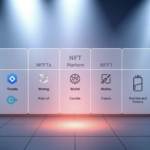Now Reading: AI powered DeFi protocols and yield farming Explained
- 01
AI powered DeFi protocols and yield farming Explained
AI powered DeFi protocols and yield farming Explained

DeFAI merges machine intelligence with decentralized finance to help everyday users automate complex choices while keeping self-custody. Agents can scan on-chain and off-chain signals, route orders across a network, and rebalance positions to improve net returns after fees.
The landscape already hosts notable platforms like Lido, Aave, Curve/Convex, GMX, Beefy, Yearn, and Pendle. Security tools such as Olympix, Nethermind’s Audit Agent, and QuillAI Shield add anomaly detection and code analysis to the ecosystem.
Expect powerful tools today but a fragmented market. Frameworks and cross-chain agent compatibility are still evolving. This guide will cover core building blocks, agent mechanics, strategies, platform comparisons, governance, risks, and practical onboarding for U.S. readers.
Key Takeaways
- DeFAI automates trading and portfolio tasks while preserving custody for users.
- Agents use multi-network signals to optimize execution and lower fees.
- Leading platforms offer varied features and reward models to explore.
- Security initiatives apply machine methods to detect anomalies and review code.
- The space is promising but immature; interoperability and standards are in progress.
What this Ultimate Guide Covers and Why It Matters Now
This guide lays out clear steps for users who want practical, up-to-date help navigating agent-led finance tools.
What you’ll find: concise definitions, how agent mechanics work, a 2025 view of staking and vaults, key platforms to follow, security advances, and risk management essentials.
Why now: explosive growth across networks makes manual discovery harder. Agents excel when they can analyze large data flows, which creates new opportunities for smarter decision-making.
U.S. readers should weigh costs on different chains, supported assets, security audits, and the regulatory posture of each platform. Beginners still face onboarding friction, and cross-chain agent interoperability remains limited.
| Topic | What’s covered | Why it matters | U.S. note |
|---|---|---|---|
| Definitions | Core terms and agent roles | Clears confusion fast | Check asset support and audits |
| Mechanics | Data flows, decision rules, execution | Shows how choices affect fees | Gas and transaction costs differ by network |
| Platforms & tools | Names to watch and feature sets | Speeds onboarding and vetting | Prefer audited services with clear transparency |
| Risk & strategy | Diversification, sizing, net APY checks | Protects capital and reduces herd risk | Regulatory clarity affects access |
By the end, readers will know how to evaluate APYs net of fees, diversify across chains, and choose tools that match their goals and risk tolerance.
Note on fragmentation: early ecosystems are split across agent frameworks. The guide shows how to mitigate onboarding pain using vetted platforms, audits, and emerging tooling like Virtuals, CGPT tooling, and Bankr wallet.
Defining DeFAI: Where AI Meets Decentralized Finance
DeFAI blends adaptive decision engines with blockchain execution to automate complex portfolio choices. These agents read onchain transactions, price feeds, and offchain signals like news or social sentiment to pick actions such as swaps, lending, or providing liquidity.
From autonomous agents to onchain execution
Agent decisions are translated into onchain actions via smart contracts. That onchain execution gives transparency and verifiability for every transaction the agent performs.
How DeFAI differs from traditional automation
Classic automation follows fixed rules, such as periodic rebalancers or basic bots. DeFAI augments those rules with machine learning and predictive models that adapt to changing market signals and broader data sets.
User permissions, constraints, and agent guardrails
Users keep control through explicit permissions, whitelists of trusted protocols, position limits, stop-loss settings, and budget caps. Permissions can be revoked and activity logs let users audit performance and costs.
For a concise primer on investment potential, see the DeFAI investment primer.
How AI Agents Work in DeFi, Step by Step
At the core, agents convert streams of onchain events and external news into executable actions on smart contracts. They begin by collecting diverse signals and end by making precise contract calls that adjust positions.
Data ingestion
Pipelines pull onchain transactions, price feeds, liquidity depth, and offchain sentiment from X and Telegram. This mix gives a fuller context for short-term moves.
Collectors normalize token formats, timestamp events, and rate feed quality to reduce noise before models see the inputs.
Decision engines
Decision layers combine supervised models, reinforcement learning policies, and rule-based safety checks. Supervised models flag patterns; policies propose actions; rules enforce limits.
Safety features include stop-loss thresholds, budget caps, and blacklists to prevent reckless contract interactions.
Onchain actions
Actions map to DEX swaps, lending adjustments, providing liquidity shifts in AMMs, and vault reallocations. Each call uses a smart contract or smart contract wallet to preserve transparency.
Execution modules route orders across networks to lower fees and control slippage during trading windows.
Learning loops and monitoring
Agents benchmark realized returns versus targets, then refine policies over time. Continuous monitoring tracks gas, fees, and network volatility to throttle activity.
Periodic reviews adjust risk sizing and strategy footprints when token behavior or market regimes change.
| Layer | Example | Purpose |
|---|---|---|
| Ingestion | Onchain events, price oracles | Context and signal quality |
| Decision | Supervised models, RL | Action proposals and safety |
| Execution | DEX swap, lending call | Position management and optimization |
Core Building Blocks: Smart Contracts, Liquidity Pools, and AMMs
Understanding the plumbing helps you judge returns and risks. Smart contracts automate lending, borrowing, and trading without intermediaries. They encode rules that execute when conditions are met.
Composability and smart contract logic
Composability lets agents stitch multiple defi protocols into one flow. A single smart contract call can route assets across lending, AMMs, and staking in sequence.
That composability accelerates strategies but adds vectors where one contract error can affect many positions.
Pool mechanics, fees, and APY basics
Liquidity pools let AMMs provide continuous liquidity. LPs earn trading fees and incentive tokens, which change net yields based on supply and demand.
Pool math — share of the pool times trading volume minus protocol fees — defines accrued returns. Incentive top-ups like Convex boosting modify net APY for LPs.
| Component | Role | Primary risk |
|---|---|---|
| Smart contracts | Automate trades & settlements | Logic bugs or exploits |
| Liquidity pools | Provide tradable depth | Impermanent loss, front-running |
| AMMs | Price discovery via formulas | Slippage and oracle issues |
Examples: Curve plus Convex boosts Curve LP returns; GMX shares perp trading fees via GLP; Lido’s stETH works across many platforms to increase utility.
Practical note: audits and long-tested code cut failure odds, but gas costs and routing choices still shape realized returns — not just headline APY.
What Is Yield Farming in 2025?
Yield farming in 2025 combines staking, liquidity provision, lending markets, and automated vaults into layered strategies that aim to boost net returns. Platforms such as Lido, Aave, Yearn, and Beefy remain core building blocks for many users.
Staking, liquidity mining, lending and vault approaches
Staking locks tokens to earn protocol rewards—stETH from Lido is a prime example. Supplying liquidity on DEXs generates trading fees plus incentive tokens. Lending on platforms like Aave pays interest to suppliers. Vaults automate these steps and auto-compound gains.
- Reward sources: trading fees, incentive tokens, staking rewards, lending interest.
- Auto-compounding: vaults (Yearn, Beefy) reinvest returns to improve net yields.
| Approach | Typical Reward | Primary Risk |
|---|---|---|
| Staking | Staking rewards | Validator & protocol risk |
| Liquidity | Trading fees + incentives | Impermanent loss, slippage |
| Lending | Interest | Liquidation & rate shifts |
| Vaults | Auto-compounded returns | Smart contract risk |
Cross-chain yield and diversification
Deploying across Ethereum, Arbitrum, Avalanche, BNB Chain, and Solana captures different fee regimes and incentive structures. Diversifying across networks cuts protocol-specific exposure and eases congestion risk.
Practical checklist: always model net returns after gas, slippage, and incentive token volatility. Compare fees and risks before allocating assets. Diversification and auto-compounding often improve long-term outcomes while limiting single-platform shocks.
AI powered DeFi protocols and yield farming
Agents continuously compare net returns across pools to steer capital toward safer, higher-expected outcomes.

APY analysis: factoring impermanent loss, gas costs, and token volatility
Models estimate net APY by starting with headline rewards and subtracting realistic costs.
That includes gas, slippage from trades, expected impermanent loss in AMMs, and token volatility losses. The system runs short simulations to forecast likely net yield under varied market moves.
Allocation logic and risk controls
Allocation rules cap exposure to correlated pools and to highly volatile tokens. Positions get size limits, staging thresholds, and decay timers to avoid crowding into the same opportunities.
Real-time monitoring and protective actions
Continuous monitoring watches pool depth, unusual inflows, and oracle divergence. Alerts flag suspicious trading or protocol events for users.
Protective actions — withdraw, hedge, or rebalance — can execute automatically within user-set guardrails to lock gains or limit downside. Scenario analysis runs stress cases to reduce herd risks before moves occur.
| Function | What it measures | Typical action |
|---|---|---|
| APY breakdown | Rewards − gas − slippage − IL | Reallocate to higher net yield |
| Exposure cap | Correlation & token volatility | Limit or scale down positions |
| Monitoring | Liquidity, flow spikes, oracle feeds | Alert or auto-withdraw |
Practical note: users should review guardrails and scenario settings. Good optimization balances upside with clear risk management to protect capital and reduce fees from excessive trading.
User Benefits: Efficiency, Personalization, and Access
Delegating routine tasks to agents frees users to focus on goals instead of mechanics. Agents automate research, execution, and rebalancing so routine work runs without constant checks.
Time savings are real: automated scans find opportunities, route trades, and rebalance portfolios on set schedules. That reduces manual work for everyday investors and busy professionals.
Personalization comes from policy settings. Users set goals, risk tolerance, and asset preferences. Agents translate those inputs into tailored strategies and position sizing.
Lowering the entry barrier improves access for newcomers. Clear interfaces and guided defaults help people join the crypto ecosystem without mastering every protocol.
- Faster decisions: automated research and execution cut response time.
- Clear reporting: transparent logs show actions, costs, and performance for user review.
- Cost efficiency: routing optimizes for lower fees and slippage, which helps smaller portfolios retain more gains.
In short, these solutions simplify portfolio management across platforms while keeping users in control. That makes modern finance tools more usable and more inclusive for U.S. investors.
Leading Platforms and Protocols to Know in the Present Market
Top platforms today combine liquid staking, automated vaults, boosted LP mechanics, and trading fee models that shape capital allocation.
Core platforms and what they offer
Lido — liquid staking via stETH; typical staking APY ~3.5%–4.5%. stETH is widely used across chains for composability.
Aave — flexible lending markets with variable APYs and flash loan features for complex trades.
Curve / Convex — stablecoin liquidity and boosted LP rewards through Convex incentives.
GMX — GLP token captures trading fee income; GLP holders often see ~10%–20% from fees and incentives.
Beefy — cross-chain auto-compounding vaults that simplify compounding across networks.
Yearn — managed vault strategies with returns that range roughly 4%–30% depending on tactics and assets.
Pendle — tokenizes future yield, offering fixed-like returns up to ~15% on certain products.
Agentic tooling and execution helpers
Virtuals creates cross-chain agent ecosystems for signal routing and execution. CGPT tooling provides Web3 assistants and contract-audit helpers. Bankr bundles an assisted wallet with token deployment workflows.
Institutional-grade approaches
Robo-advisors and compliant services now offer audited strategies, custody options, and reporting for tax and compliance needs.
| Platform | Core feature | Typical APY range |
|---|---|---|
| Lido | Liquid staking (stETH) | 3.5%–4.5% |
| GMX | Trading fee share (GLP) | 10%–20% |
| Yearn | Managed vaults | 4%–30% |
| Pendle | Future-yield tokens | Up to ~15% |
Composability matters: stETH, LP tokens, and vault shares move across stacks to build layered strategies. Match platform features to your goals, network costs, and risk limits before allocating assets.
Security First: AI for Smart Contract and Protocol Defense
Tools that watch transaction flows and contract calls can flag subtle anomalies early. This kind of monitoring reduces exposure by catching odd patterns before they escalate.

Threat detection, anomaly monitoring, and predictive alerts
Machine learning models baseline normal contract activity and surface deviations in real time. They use historical data to spot spikes in transfers, unusual approvals, or sudden liquidity shifts.
Predictive alerts warn teams so they can pause contracts, revoke permissions, or trigger investigations.
AI-augmented audits and code analysis before deployment
Static analysis catches coding patterns that often lead to exploits. Dynamic analysis runs contract fragments to reveal runtime failures.
Pre-deployment analysis finds issues that manual review can miss, improving release confidence.
Notable initiatives
- Olympix — threat prediction and flow analysis for live networks.
- Nethermind’s Audit Agent — automated bug discovery in source code.
- QuillAI Shield — continuous monitoring and tailored detection for defi.
| Defense Layer | What it checks | Primary benefit |
|---|---|---|
| Pre-deploy analysis | Static code patterns, unit test failures | Fewer logic flaws at launch |
| Runtime monitoring | Transaction flows, approvals, oracle feeds | Early exploit detection |
| Operational controls | Bug bounties, incident playbooks | Faster response and recovery |
Practical advice: weigh a project’s security track record alongside APY. Layered defenses — audits, bug bounties, runtime monitoring, and alerting — cut risks and protect user funds in the crypto ecosystem.
Risk Management Essentials for Yield Farmers
Practical controls—position caps, buffers, and scenario tests—keep strategies resilient. Clear rules help users limit downside when markets move fast.
Impermanent loss, liquidation, and protocol failure
Impermanent loss (IL) happens when a token pair diverges in price. Volatile pairs increase IL compared with stable pairs. Stable-stable pools usually cut exposure.
Liquidation risk appears when collateral falls below thresholds on lending platforms. A larger buffer reduces forced unwinds and costly slippage.
Protocol risk covers bugs, governance failures, and exploits. Favor audited code, conservative TVL caps, and insurance where available to reduce those risks.
Herding from similar strategies
When many agents run the same strategies, exits can become crowded. Crowded moves amplify drawdowns and raise fees during rebalancing.
Diversify, size, and stress-test positions
Spread assets across chains and platform types to limit single-point failures. Size positions to protect capital and avoid margin calls.
- Use scenario tests for sharp price moves and fee spikes.
- Set rebalancing cadence that accounts for fees and market impact.
- Maintain emergency liquidity and clear stop-loss rules.
| Risk Type | What It Affects | Mitigation |
|---|---|---|
| Impermanent loss | LP positions and net yields | Choose stable pairs or hedge exposure |
| Liquidation | Borrowed positions and collateral | Increase buffers; lower leverage |
| Protocol failure | Staked or locked assets | Prefer audited projects; limit TVL share |
| Herding | Exit liquidity and fees | Diversify strategies; stagger rebalances |
Data and Analytics: Fueling Better Strategies
Quantitative rankings and backtests turn noisy market signals into clear trade candidates. Good analytics steer users toward realistic opportunities and away from headline traps.
Grades, rankings, and realistic backtesting
Grades and token rankings compress many metrics into a single view. Scores for CVX, GMX, and LDO help filter early candidates.
Backtesting should include realistic gas and slippage assumptions. Run scenarios that model fees and rare price moves before allocating capital.
Fees, slippage, and narrative tracking
Compare transaction fees across chains and DEXs to improve net yields. Small fee differences compound over time.
Narrative tracking spots protocol momentum before APYs peak. Watch on-chain flows, developer activity, and social signals for early signs.
Ongoing monitoring and dashboards
- Grades: filter opportunities fast.
- Backtests: validate strategies with real costs.
- Dashboards: track positions, realized performance, and fee impact.
| Tool | Main feature | What to check | Benefit |
|---|---|---|---|
| Token Metrics | Grades & rankings | Signal history, score drivers | Quick opportunity filtering |
| Backtest suite | Simulation | Gas, slippage, order routing | Realistic performance estimates |
| Narrative tracker | Sentiment flow | Developer activity, onchain volume | Early momentum detection |
| Dashboard | Portfolio view | Realized fees, net returns | Ongoing management |
For further reading on integration themes, see this guided analysis.
Governance in an AI-Driven DeFi Ecosystem
Onchain voting now benefits from systems that summarize proposals, forecast outcomes, and flag key trade-offs.

Agents can read long DAO text, extract the core asks, and show likely token-holder impacts. That helps users move from noise to clear choices fast.
Delegation frameworks let members route votes to trusted delegates under defined guardrails. Safeguards include revocation windows, quorum limits, and staged execution to reduce misuse.
Transparency matters: every recommendation should include a rationale, data sources, and an audit trail so communities can verify why plans were suggested.
Ethical concerns remain. Black-box models can obscure how a vote was chosen. Accountability paths—signed explanations, human review, and appeal channels—help solve those gaps.
| Feature | Benefit | Safeguard |
|---|---|---|
| Proposal summary | Faster decisions | Source links |
| Outcome forecast | Risk visibility | Scenario tests |
| Delegated vote | Scale participation | Revocation window |
Practical step: tie participation rewards like airdrop qualification or beta access to active, accountable voting. That promotes healthy engagement while keeping oversight tight.
Interoperability and the Path to Agent-to-Agent Economies
Cross-chain gaps limit how fast agents react to shifting liquidity across networks. Today, most frameworks operate on a single chain, which narrows market view and delays execution when opportunities appear elsewhere.
Cross-chain constraints today and the multi-chain future
Present hurdles include messaging reliability, finality differences, and bridge risk. Messages can fail or reorder. Finality varies by chain, which complicates safe settlement. Bridges add custody and slippage exposure.
Short-term fixes use relayers, optimistic receipts, and time-locked actions to reduce risk. Longer-term fixes need secure interoperability layers that respect each chain’s finality model.
Intent-based execution and agent negotiations across networks
Intent-based flows let users state desired outcomes while agents handle the how. Agents would negotiate liquidity, price, and routing across chains to meet that intent.
- Autonomous negotiation could match offers across networks to find best price.
- Standard interfaces will let agents discover features and activity on remote chains.
- Multi-chain expansion reduces fragmentation and improves user access to opportunities.
| Constraint | Impact | Needed feature |
|---|---|---|
| Messaging | Delayed actions | Reliable relayers |
| Finality | Settlement risk | Cross-chain proofs |
| Bridges | Custodial exposure | Trustless interoperability |
Practical note: standard APIs, secure middleware, and clear governance will unlock agent-to-agent economies. That shift can broaden the ecosystem, let crypto strategies span chains, and improve portfolio management for U.S. users.
Cost, Fees, and Transaction Optimization
Transaction costs often decide whether a strategy makes money or simply eats fees.
Net returns hinge on gas costs, withdrawal fees, performance cuts, and slippage. Small portfolios or frequent rebalances feel these effects most. Compare transaction fees across platforms before allocating capital.
Key fee types:
| Fee type | What it affects | Action |
|---|---|---|
| Protocol fee | Gross reward share | Pick audited platforms with clear splits |
| Gas | Per-transaction cost | Batch when possible, prefer off-peak |
| Performance/exit | Withdrawals and harvests | Time rebalances to avoid penalties |
Routing to deeper liquidity lowers slippage on larger trades. Agents can batch orders, throttle frequency, and schedule transactions in low-fee windows to balance alpha with cost. Finally, run per-network comparisons since gas dynamics vary widely by chain and market conditions.
Tooling and Platform Selection Criteria for U.S. Users
For U.S. users, platform selection should prioritize audits, governance health, and transparent fee models. Start by checking public reports, incident histories, and how teams communicate changes. Clear disclosure helps reduce unseen risks.

Security audits, protocol health, and transparency
Prioritize platforms with repeated third-party audits, active bug bounty programs, and a clean incident record. Regular audits and public remediation logs signal mature security practices.
- Audit cadence: recent major audits and follow-up fixes.
- Bug bounties: active programs with paid disclosures.
- Time in market: steady operation without repeated failures.
- Incident history: clear post-mortems when issues occur.
UX, supported assets, regulatory posture, and community
Assess user experience, supported assets, and custody options to match your comfort level. Good UX reduces mistakes. Strong communities and clear docs improve access for newcomers.
- Check TVL trends and liquidity depth for the assets you plan to use.
- Verify custodial vs. non-custodial integrations before depositing funds.
- Look for institutional-grade signals: audited financials, clear disclosures, and responsive governance.
| Criterion | What to check | Why it matters | Quick signal |
|---|---|---|---|
| Security | Audit reports, bounties, incident logs | Reduces exploit risk | Recent audit + bounty |
| Liquidity & TVL | TVL trends, depth by asset | Supports large trades and exits | Stable or growing TVL |
| UX & Features | Interface clarity, docs, onboarding | Low user error, better access | Guides, sandbox, clear fees |
| Regulatory posture | Disclosures, compliance tools, US signals | Legal clarity for users | Public compliance notes |
Practical checklist: confirm audits, bug bounties, time in market, incident history, TVL and liquidity, supported assets, custody model, UX polish, community response, and any U.S. disclosures. Use these points to compare platforms and to tailor strategies that match your risk tolerance and finance goals.
Getting Started: A Practical, Risk-Aware Onboarding Flow
Start by translating your financial goals into clear targets. Pick a time horizon, an acceptable drawdown, and a realistic net return after fees. These targets will guide which networks and assets fit your plan.
Define goals, choose networks, set permissions and budgets
Set risk and return targets, then match networks to the assets you want. Favor chains with fee profiles that suit small or large positions.
Whitelist trusted platforms like Lido, Aave, Curve/Convex, GMX, Beefy, Yearn, and Pendle. Cap exposure per position and limit agent permissions to only needed actions.
Start with audited platforms; monitor performance and adjust
Fund agents conservatively. Budget gas and review fee schedules before live transactions. Begin with small allocations and run scheduled performance checks.
Track slippage, realized fees, and unexpected behavior. Iterate on settings, add cross-chain complexity slowly, and introduce vault layering or hedges only after proven performance.
| Step | Action | Why |
|---|---|---|
| Goal setting | Define time, drawdown, net return | Aligns strategies and networks |
| Permissions | Whitelist platforms; cap exposure | Limits protocol risk |
| Budgeting | Plan gas and fees; start small | Protects capital while testing |
| Review | Monthly performance and adjust | Improves management and outcomes |
Optimizing Your Strategy Over Time
Optimization is an ongoing task that balances compounding benefits with fee drag and market shifts.
Start with clear rebalancing rules: set thresholds (for example, 3–5% drift) or fixed intervals (weekly, monthly). These rules reduce unnecessary trading and protect returns from frequent fees.
Rebalancing, auto-compounding, and harvest schedules
Auto-compounding (Yearn- and Beefy-style) increases effective APY by reinvesting earnings. But each harvest costs gas and can create slippage.
Match harvest timing to portfolio size and network fees. For small allocations, longer intervals often beat frequent harvesting because fees eat gains.
Use a hybrid approach: time-based compounding for steady assets and threshold-based harvesting for volatile tokens.
Incorporating narratives, signals, and market regimes
Sentiment tools like Token Metrics help align allocations with evolving themes. Treat narratives as inputs, not directives.
Adapt allocations to market regimes: reduce exposure during high volatility, favor deeper liquidity when markets thin, and increase cash buffers when gas spikes.
- Set rebalancing triggers to avoid churn.
- Time harvests to balance compounding gains vs. fees.
- Shift weight by regime—volatility, liquidity, or calm markets.
- Validate narratives with analytics; avoid chasing lagging trends.
- Review slippage, gas trends, and realized performance on a set cadence.
| Action | When to apply | Key benefit |
|---|---|---|
| Threshold rebalance | Asset deviates by 3–5% | Limits needless trading |
| Scheduled harvest | Monthly or quarterly (small portfolios) | Improves net compounding |
| Regime shift | High volatility or low liquidity | Reduces drawdown risk |
| Signal validation | Before allocation changes | Prevents narrative chasing |
Practical cadence: review performance monthly, check slippage and gas weekly, and re-evaluate strategy features quarterly. This keeps management efficient and focused on long-term results for U.S. users.
Where DeFAI Is Headed Next—and How to Prepare
A shift toward multi-chain intent execution will let autonomous agents find better routes and price outcomes across the modern finance landscape.
Expect agent-to-agent economies to grow as frameworks converge. The industry and space will gain maturity through stronger security, analytics, and clearer governance.
The ecosystem will offer friendlier interfaces that mask complexity while keeping transparency. This expands access for retail users and institutions alike.
Prepare by standardizing monitoring, diversifying assets, and choosing audit-first projects. Small steps in tooling and process reduce risk while unlocking new opportunities.
The potential for transformative change is high — stay informed, keep controls tight, and focus on durable practices as the space evolves.















